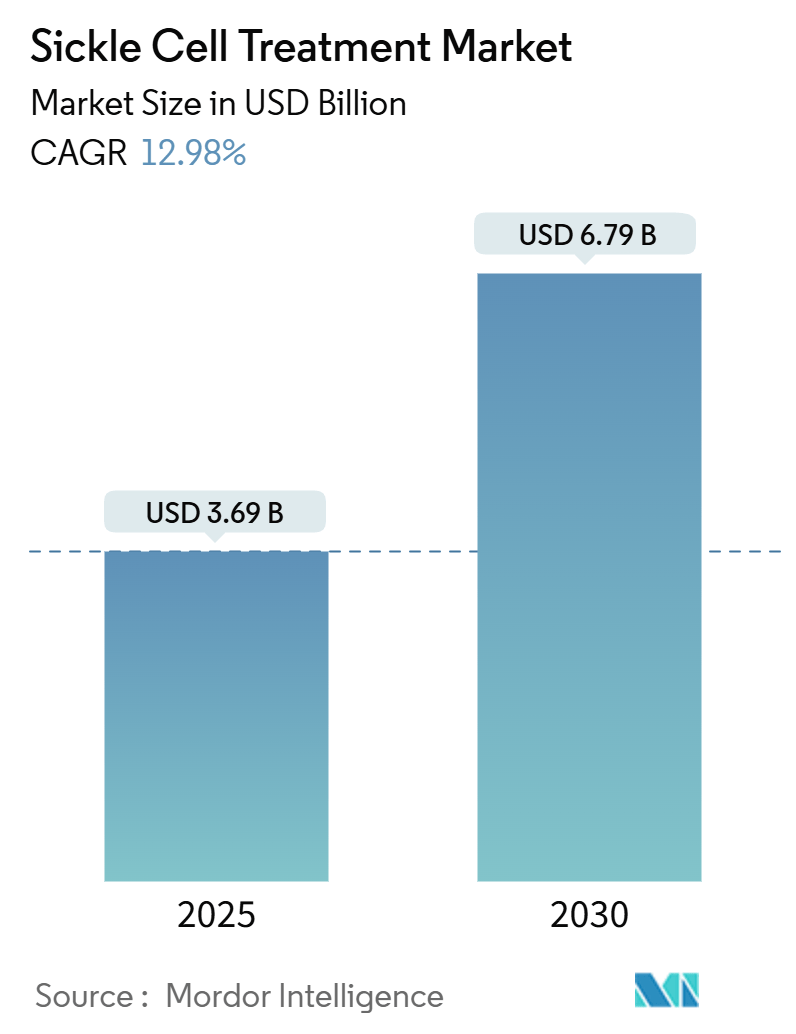
| Study Period | 2019 - 2030 |
| Market Size (2025) | USD 3.69 Billion |
| Market Size (2030) | USD 6.79 Billion |
| CAGR (2025 - 2030) | 12.98 % |
| Fastest Growing Market | Asia-Pacific |
| Largest Market | North America |
| Market Concentration | Low |
Major Players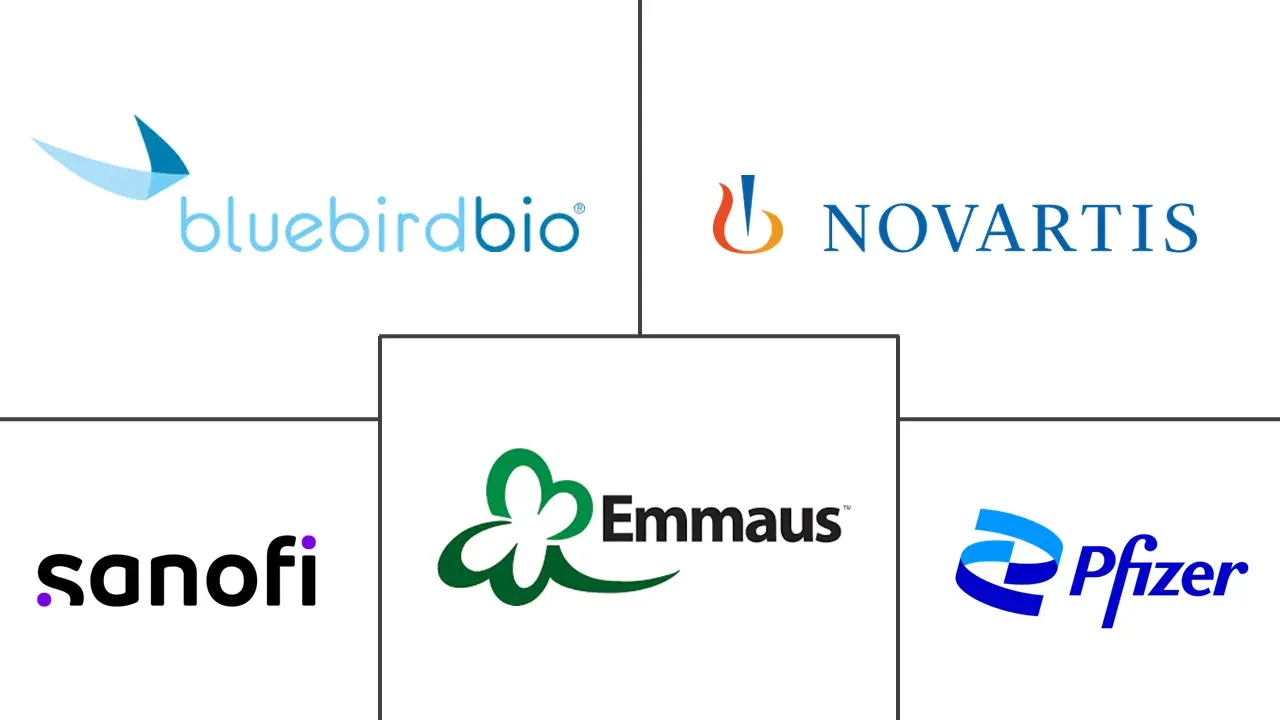
*Disclaimer: Major Players sorted in no particular order |
Sickle Cell Treatment Market Analysis
The Sickle Cell Treatment Market size is estimated at USD 3.69 billion in 2025, and is expected to reach USD 6.79 billion by 2030, at a CAGR of 12.98% during the forecast period (2025-2030).
The global sickle cell disease treatment landscape is experiencing significant transformation driven by evolving healthcare infrastructure and increasing international collaboration. Healthcare systems worldwide are adapting to address the growing burden of genetic blood disorders, with particular emphasis on regions most affected by sickle cell disease. According to the World Health Organization's 2022 data, more than 66% of the 120 million people affected worldwide by sickle cell disease live in Africa, with approximately 1,000 children born with the disease every day in the region, making it the most prevalent genetically acquired disease in Africa. This geographical distribution has led to increased focus on developing robust healthcare infrastructure and treatment accessibility in high-burden regions.
Technological advancements in gene therapy and personalized medicine are reshaping treatment approaches for sickle cell disease. Healthcare providers are increasingly adopting innovative therapeutic solutions, including novel drug delivery systems and targeted therapies. The integration of artificial intelligence and data analytics in treatment planning has enabled more precise patient monitoring and improved outcomes. These technological developments are complemented by the emergence of specialized treatment centers and the implementation of comprehensive care models that address both the physical and psychosocial aspects of the disease. The rise of genetic medicine and sickle cell therapy is pivotal in these advancements.
International healthcare partnerships and cross-border collaborations are playing a crucial role in advancing sickle cell therapy globally. Major pharmaceutical companies are forming strategic alliances with regional healthcare providers to expand treatment accessibility and improve patient care delivery systems. These partnerships are facilitating knowledge transfer, resource sharing, and the establishment of standardized treatment protocols across different geographical regions. The collaboration between healthcare institutions has also led to the development of more efficient patient management systems and improved treatment outcomes.
Healthcare policy reforms and infrastructure development initiatives are creating a more supportive environment for sickle cell disease treatment. Governments and healthcare organizations are implementing comprehensive screening programs and developing specialized treatment facilities to address the growing patient population. According to HemaSphere's June 2022 report, the disease maintains a significant presence across Sub-Saharan Africa, the Mediterranean, the Middle East, and India, prompting these regions to strengthen their healthcare infrastructure and treatment capabilities. These developments are accompanied by increasing investment in healthcare worker training and the establishment of specialized care units dedicated to managing sickle cell disease. The focus on hemoglobinopathy treatment and rare hematology is essential in these regions.
Sickle Cell Treatment Market Trends
Increasing Prevalence of Sickle Cell Disease
The rising prevalence of sickle cell disease (SCD) globally has become a significant concern for healthcare systems and is driving the demand for effective sickle cell disease treatment. According to the Centers for Disease Control and Prevention's May 2022 update, approximately 100,000 Americans are affected by SCD annually, with the condition occurring in about 1 out of every 365 Black or African American births and 1 out of every 16,300 Hispanic American births. The genetic nature of the disease is further highlighted by the fact that about 1 in 13 Black or African-American babies is born with sickle cell trait (SCT), indicating a substantial at-risk population that requires monitoring and potential treatment.
The global burden of SCD continues to expand beyond traditional high-prevalence regions. According to an article published by HemaSphere in August 2022, research conducted in India revealed an unexpectedly high prevalence of sickle cell disease among non-tribal populations in Chattisgarh, indicating the disease's expanding geographical reach. This finding is particularly significant as it demonstrates the need for expanded screening and treatment programs in previously underserved regions. The Canadian Pediatric Society's February 2022 report further emphasizes the growing prevalence, noting that SCD affects at least 5,000 individuals in Canada annually, making it one of the most common human genetic diseases in the region.
Increasing Research and Development Activity
The sickle cell treatment market is experiencing significant momentum in research and development activities, driven by substantial investments and fast-track designations from regulatory authorities. In September 2022, the National Institutes of Health (NIH) demonstrated its commitment to advancing SCD treatment by awarding a five-year, USD 7.7 million grant to support research aimed at reducing healthcare barriers for people with sickle cell disease. This substantial funding is complemented by regulatory support, as evidenced by the FDA's decision in May 2022 to award fast-track designation to Graphite Bio's GPH101, an innovative gene-editing therapy designed to correct the genetic mutation causing SCD with potential curative properties.
The intensity of R&D activities is further demonstrated by the numerous clinical trials and new treatment approaches being investigated. According to data updated by ClinicalTrials.gov in February 2023, there are 58 ongoing and active clinical trials specifically focused on blood transfusion in sickle cell disease, indicating robust research pipeline activity. The pharmaceutical industry's commitment to developing innovative treatments is exemplified by companies like Agios Pharmaceuticals, which launched a significant phase 2/3 trial called RISE UP in January 2022 to test its investigational therapy mitapivat (AG-348) in SCD patients. These research initiatives span various treatment modalities, from traditional approaches to cutting-edge sickle cell therapy, reflecting the industry's comprehensive effort to address the unmet needs in SCD treatment. The designation of treatments as orphan drug status further highlights the specialized focus within the cell therapy market.
Segment Analysis: By Treatment Modality
Blood Transfusion Segment in Sickle Cell Treatment Market
Blood transfusion represents the dominant segment in the global sickle cell treatment market, accounting for approximately 41% of the total market share in 2024. This significant market position is attributed to the high demand for blood transfusions in sickle cell treatment and their effectiveness in enhancing hemoglobin levels to improve oxygen delivery in the body. Blood transfusions enable the supply of normal red blood cells, which helps reduce sickle cell blockage in blood vessels and minimizes the formation of more sickle cells. The segment's leadership is further strengthened by the increasing adoption of transfusion support as a key intervention in managing various complications related to sickle cell disease, with over 50% of SCD children receiving at least one or more blood transfusions during their pediatric lifetime. The blood transfusion market continues to expand as these procedures remain critical in sickle cell disease treatment.
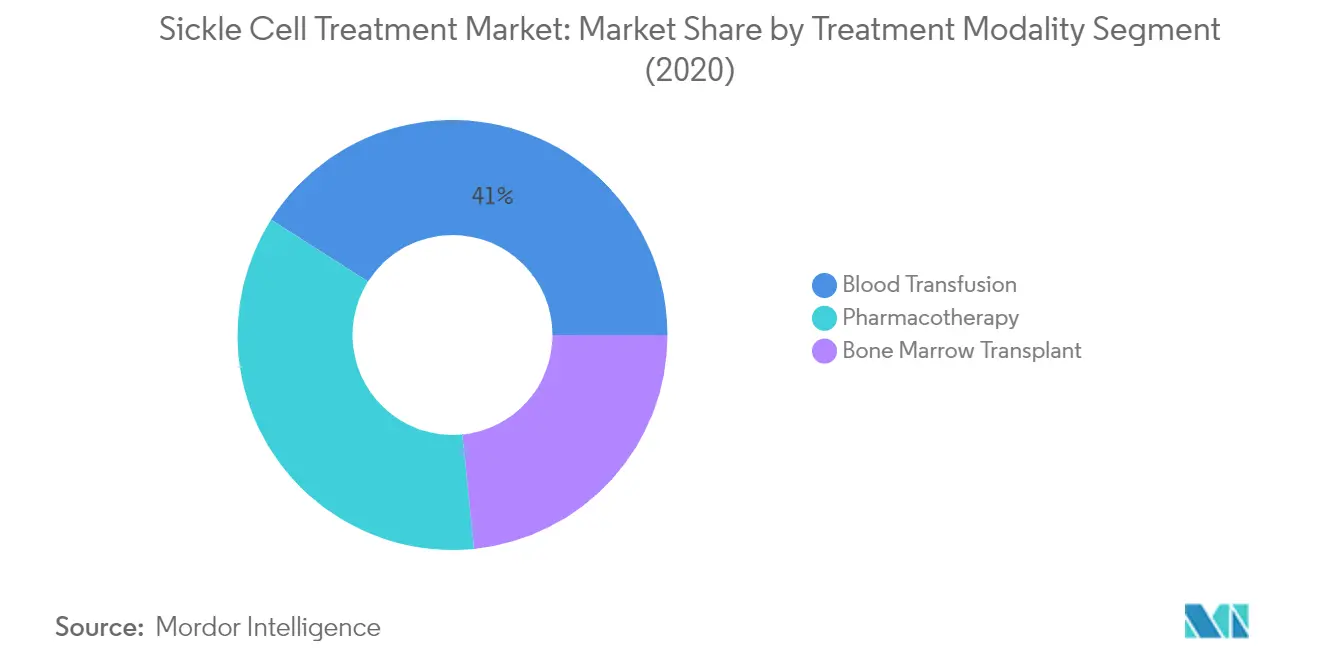
Pharmacotherapy Segment in Sickle Cell Treatment Market
The pharmacotherapy segment is emerging as the fastest-growing segment in the sickle cell treatment market, projected to grow at approximately 19% during 2024-2029. This rapid growth is driven by continuous advancements in drug development and expanding therapeutic options. Currently, there are over 54 drugs either being used or under consideration for treating sickle cell disease. The segment's growth is further accelerated by the introduction of innovative medications and expanding treatment options, including drugs like Hydroxyurea, Voxelotor, L-Glutamine, and Crizanlizumab. The increasing focus on developing novel therapeutic solutions and the rising number of drug approvals are expected to maintain this segment's strong growth trajectory in the coming years.
Remaining Segments in Treatment Modality
The bone marrow transplant segment represents a crucial component of the sickle cell treatment market, offering the only known potential cure for the disease. This segment's significance is underlined by its high success rate in treating sickle cell disease, particularly in children. The procedure involves replacing abnormal stem cells with healthy ones from eligible donors, typically siblings. The segment continues to evolve with advancements in transplant techniques and expanding access to treatment centers, making it an increasingly viable option for patients seeking long-term solutions to sickle cell disease.
Segment Analysis: By End User
Hospitals Segment in Sickle Cell Treatment Market
The hospitals segment dominates the global sickle cell treatment market, accounting for approximately 64% of the total market share in 2024. This significant market position is attributed to the comprehensive care capabilities and advanced treatment facilities available in hospital settings. The increasing number of hospitals across various regions, particularly in developing countries, has strengthened this segment's dominance. Modern hospitals are equipped with specialized departments and advanced technologies necessary for blood transfusions, bone marrow transplants, and other critical procedures required for sickle cell treatment. The presence of skilled healthcare professionals, emergency care facilities, and the ability to handle complications associated with sickle cell disease makes hospitals the primary choice for treatment. Additionally, the integration of specialized sickle cell treatment units within hospital systems and the implementation of automated location-based technologies for monitoring nurse workflow and blood transfusion procedures has further enhanced the segment's market position.
Specialty Clinics Segment in Sickle Cell Treatment Market
The specialty clinics segment is emerging as the fastest-growing segment in the sickle cell treatment market, projected to experience robust growth during the forecast period 2024-2029. This accelerated growth is driven by the increasing trend towards specialized care centers focused exclusively on sickle cell disease management. Specialty clinics are gaining prominence due to their focused approach, personalized treatment plans, and expertise in handling specific aspects of sickle cell disease. These facilities are increasingly adopting innovative treatment protocols and participating in clinical trials, making them crucial centers for advancing sickle cell treatment methodologies. The rise in outpatient visits for regular monitoring and treatment, coupled with the establishment of new specialized centers in various regions, is contributing to this segment's rapid expansion. Furthermore, the integration of telemedicine services and collaborative care models in specialty clinics has enhanced their accessibility and effectiveness in managing sickle cell disease patients.
Remaining Segments in End User Market
The other end users segment, which includes blood banks, research centers, and academic institutions, plays a vital role in the sickle cell treatment market ecosystem. These facilities contribute significantly to the advancement of treatment methodologies through research initiatives and clinical trials. Blood banks serve as crucial support systems for both hospitals and specialty clinics by ensuring a steady supply of blood products for transfusion therapies. Academic institutions and research centers are instrumental in developing new treatment approaches and conducting studies that enhance the understanding of sickle cell disease. The collaboration between these various entities creates a comprehensive network that supports both routine treatment delivery and the advancement of therapeutic options for sickle cell disease patients.
Sickle Cell Treatment Market Geography Segment Analysis
Sickle Cell Treatment Market in North America
North America represents a significant market for the sickle cell disease treatment market, encompassing the United States, Canada, and Mexico. The region benefits from advanced healthcare infrastructure, high healthcare spending, and a strong presence of key market players. The market is driven by the increasing prevalence of sickle cell disease, particularly among African American populations, coupled with favorable reimbursement policies and growing research activities in gene therapy and bone marrow transplantation. The presence of established healthcare facilities and increasing awareness about treatment options has made North America a leading region in sickle cell disease management.
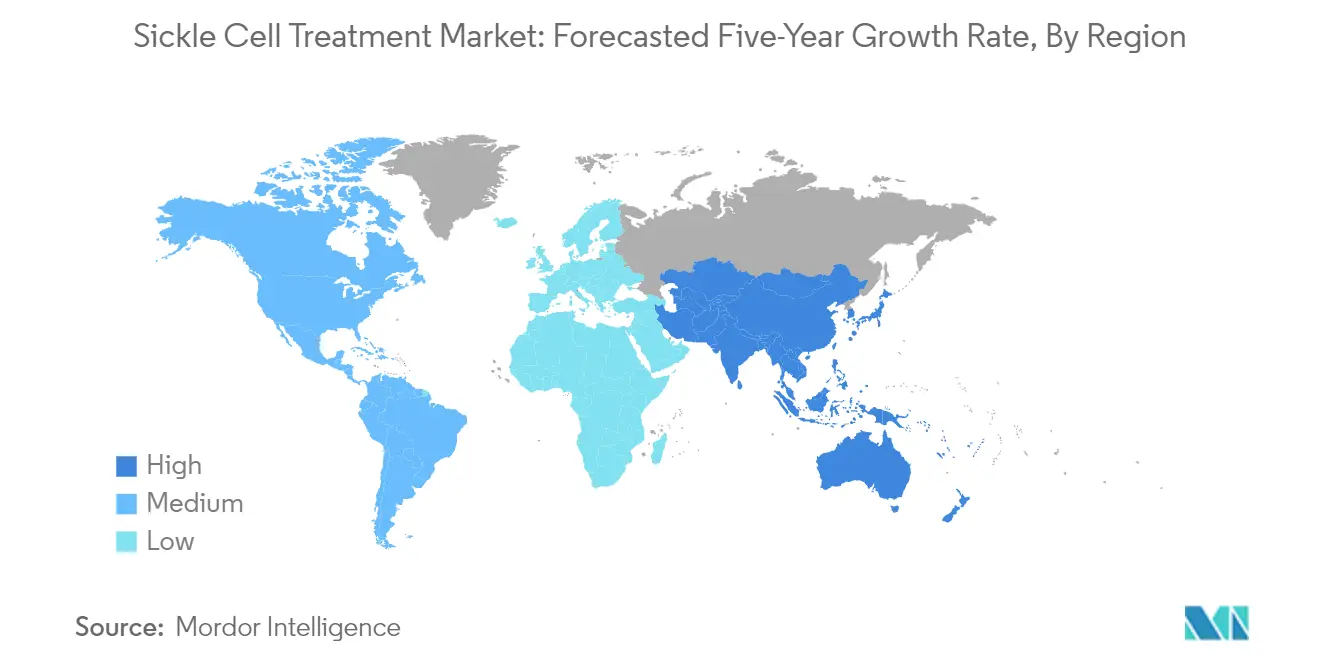
Sickle Cell Treatment Market in United States
The United States dominates the North American sickle cell therapy market, holding approximately 82% share of the regional market in 2024. The country's market leadership is attributed to factors such as high disease prevalence, with sickle cell disease affecting approximately 1 in every 365 Black or African-American births. The presence of major pharmaceutical companies, extensive research and development activities, and a favorable regulatory environment further strengthen the market. The FDA's support for accelerated approvals and breakthrough designations for sickle cell treatments has encouraged innovation in this space. Additionally, comprehensive healthcare coverage and strong advocacy groups have improved access to advanced treatments.
Growth Dynamics in United States Sickle Cell Treatment Market
The United States is also the fastest-growing market in North America, with an expected CAGR of approximately 18% during 2024-2029. This growth is driven by increasing investment in gene therapy research, expanding clinical trials, and rising adoption of novel treatment approaches. The country's robust pipeline of innovative therapies, including CAR-T cell therapies and gene editing technologies, contributes to market expansion. Furthermore, growing collaboration between research institutions and pharmaceutical companies, coupled with increasing government funding for rare disease research, supports market growth.
Sickle Cell Treatment Market in Europe
The European sickle cell disease treatment market encompasses key countries including Germany, the United Kingdom, France, Italy, Spain, Belgium, and the Netherlands. The region demonstrates strong market potential due to its well-established healthcare systems and increasing focus on rare disease management. European countries have implemented comprehensive screening programs and specialized treatment centers for sickle cell disease. The market benefits from strong research collaboration between academic institutions and pharmaceutical companies, particularly in developing innovative therapies.
Sickle Cell Treatment Market in Germany
Germany leads the European sickle cell treatment market, commanding approximately 19% of the regional market share in 2024. The country's market leadership is supported by its robust healthcare infrastructure and significant investment in medical research. Germany has established specialized treatment centers and comprehensive care programs for sickle cell patients. The country's strong focus on developing innovative therapies and its favorable reimbursement policies have attracted major pharmaceutical companies to conduct clinical trials and launch new treatments.
Growth Dynamics in French Sickle Cell Treatment Market
France emerges as the fastest-growing market in Europe, with an anticipated CAGR of approximately 18% during 2024-2029. The country's growth is driven by increasing disease awareness, an expanding patient population, and strong government support for rare disease research. France has implemented comprehensive screening programs and specialized care networks for sickle cell disease patients. The country's commitment to developing innovative treatments and its strong focus on patient care quality have created a favorable environment for market expansion.
Sickle Cell Treatment Market in Asia-Pacific
The Asia-Pacific region, comprising China, Japan, India, Australia, and South Korea, represents a significant market for sickle cell therapy. The region demonstrates growing potential due to its large population base, increasing healthcare expenditure, and improving awareness about genetic disorders. Countries in this region are strengthening their healthcare infrastructure and implementing screening programs for early disease detection. The market is characterized by increasing collaboration between international pharmaceutical companies and local healthcare providers.
Sickle Cell Treatment Market in India
India emerges as the largest market in the Asia-Pacific region, driven by its high disease prevalence and expanding healthcare infrastructure. The country has implemented comprehensive screening programs and established specialized treatment centers across various regions. The government's initiatives to improve healthcare access in rural areas and increasing awareness about genetic disorders have contributed to market growth. India's growing focus on developing cost-effective treatments and expanding healthcare coverage has created opportunities for market expansion.
Growth Dynamics in Indian Sickle Cell Treatment Market
India also leads the growth trajectory in Asia-Pacific, supported by increasing government initiatives and expanding healthcare infrastructure. The country's focus on developing indigenous treatment options and improving healthcare accessibility drives market expansion. The establishment of new treatment centers, implementation of screening programs, and increasing collaboration with international research institutions contribute to market growth. India's efforts to enhance awareness about genetic disorders and improve treatment accessibility in rural areas further support market development.
Sickle Cell Treatment Market in Middle East & Africa
The Middle East & Africa region, including GCC countries and South Africa, presents unique opportunities in the sickle cell disease treatment market. The region is characterized by high disease prevalence, particularly in certain ethnic groups, and growing healthcare infrastructure. While the GCC countries lead in terms of market size due to their advanced healthcare systems and higher healthcare spending, South Africa shows promising growth potential. The region's market is supported by increasing government initiatives for disease awareness, improving healthcare infrastructure, and growing collaboration with international healthcare providers.
Sickle Cell Treatment Market in South America
The South American market, primarily driven by Brazil and Argentina, demonstrates growing potential in sickle cell treatment. The region's market is characterized by increasing disease awareness, improving healthcare infrastructure, and growing government support for rare disease management. Brazil emerges as both the largest and fastest-growing market in the region, supported by its comprehensive healthcare system and increasing focus on genetic disorder management. The region's market growth is further driven by expanding access to advanced treatments and growing collaboration with international pharmaceutical companies.
Sickle Cell Treatment Industry Overview
Top Companies in Sickle Cell Treatment Market
The sickle cell treatment market features established pharmaceutical companies like Novartis AG, Bristol Myers Squibb, Pfizer, and Sanofi SA alongside specialized biotechnology firms such as Global Blood Therapeutics, Bluebird Bio, and CRISPR Therapeutics. These companies are heavily investing in research and development to advance gene therapy and innovative treatment solutions. The industry demonstrates strong product innovation through pipeline developments in gene editing technologies, particularly genetic medicine and novel drug formulations. Companies are pursuing strategic collaborations and licensing agreements to enhance their technological capabilities and expand market reach. Operational agility is evident through the establishment of dedicated research facilities and manufacturing partnerships, while geographic expansion focuses on both developed markets and emerging economies with high disease prevalence.
Consolidated Market with Strong Growth Potential
The sickle cell treatment market exhibits moderate consolidation, characterized by the presence of both global pharmaceutical conglomerates and specialized biotech firms. Large pharmaceutical companies leverage their extensive research capabilities, established distribution networks, and financial resources to maintain market leadership, while specialized firms focus on developing breakthrough therapies through innovative technologies. The market has witnessed significant merger and acquisition activity, particularly involving larger companies acquiring smaller biotech firms to strengthen their pipeline and technological capabilities.
The competitive dynamics are shaped by strategic partnerships between research institutions, pharmaceutical companies, and biotechnology firms, creating a collaborative ecosystem for drug development. Market participants are increasingly focusing on developing comprehensive treatment portfolios rather than single-product approaches. Regional players, particularly in emerging markets, are gaining prominence through local manufacturing capabilities and distribution partnerships with global companies, contributing to market expansion and accessibility of treatments.
Innovation and Accessibility Drive Market Success
Success in the sickle cell treatment market increasingly depends on companies' ability to develop breakthrough therapies while ensuring treatment accessibility. Incumbent companies must focus on expanding their research and development capabilities, particularly in gene therapy and precision medicine, while maintaining strong relationships with healthcare providers and payers. Building robust distribution networks, especially in regions with high disease burden, and developing patient support programs are crucial strategies for market leadership. Companies must also navigate complex regulatory environments and demonstrate strong safety and efficacy profiles for their treatments.
Market contenders can gain ground by focusing on specific therapeutic areas or novel treatment approaches, particularly in underserved market segments. The relatively low threat of substitute products provides opportunities for companies with innovative solutions, though regulatory compliance and clinical trial success remain critical challenges. End-user concentration in specialized treatment centers and hospitals necessitates strong relationships with healthcare providers and effective market access strategies. Future success will depend on companies' ability to balance innovation with cost-effectiveness, particularly as healthcare systems globally focus on value-based care models. Additionally, the orphan drug industry plays a crucial role in driving innovation and accessibility, given the rare nature of sickle cell disease.
Sickle Cell Treatment Market Leaders
-
Novartis AG
-
Emmaus Medical Inc.
-
Sanofi SA
-
Bluebird bio, Inc.
-
Pfizer
- *Disclaimer: Major Players sorted in no particular order
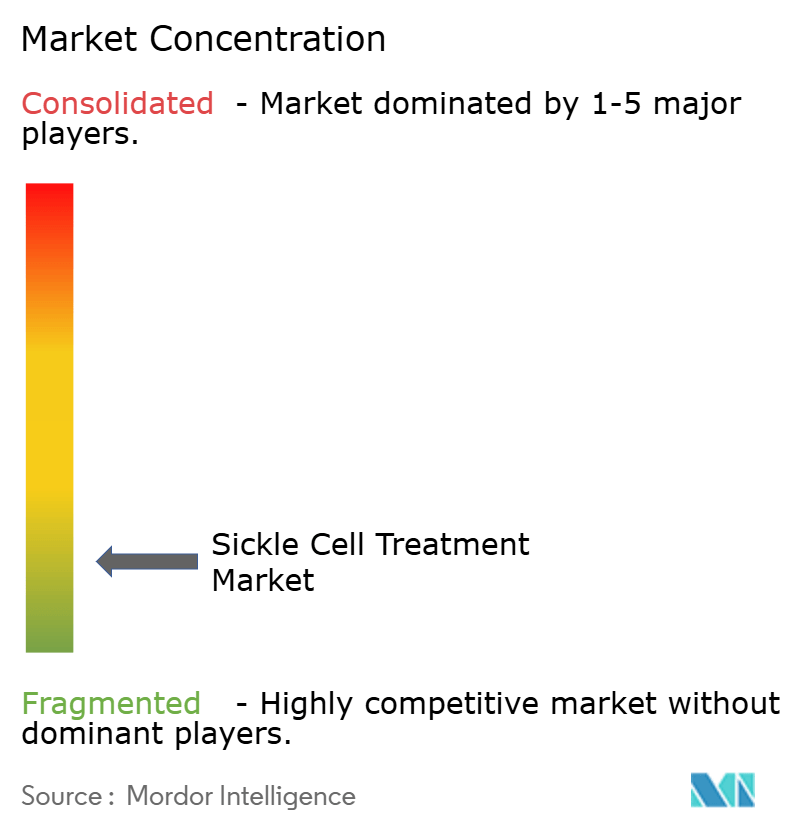
Sickle Cell Treatment Market News
- October 2024: The United States Food and Drug Administration (FDA) awarded Orphan Drug Designation (ODD) to AND017 for treating sickle cell disease (SCD). This designation highlights the critical need for new treatments, especially oral medications that can safely and effectively address the needs of SCD patients.
- March 2024: Akums Drugs and Pharmaceuticals introduced an oral suspension of Hydroxyurea, which is stable at room temperature and can manage sickle cell disease (SCD). This medication eradicates the requirement for cold storage, thus increasing its accessibility and affordability for SCD patients across India.
Sickle Cell Treatment Market Report - Table of Contents
1. INTRODUCTION
- 1.1 Study Assumptions and Market Definition
- 1.2 Scope of the Study
2. RESEARCH METHODOLOGY
3. EXECUTIVE SUMMARY
4. MARKET DYNAMICS
- 4.1 Market Overview
-
4.2 Market Drivers
- 4.2.1 Increasing Prevalence of Sickle Cell Disease
- 4.2.2 Increasing R&D Activity
-
4.3 Market Restraints
- 4.3.1 High Cost of Treatment
-
4.4 Porter's Five Forces Analysis
- 4.4.1 Threat of New Entrants
- 4.4.2 Bargaining Power of Buyers/Consumers
- 4.4.3 Bargaining Power of Suppliers
- 4.4.4 Threat of Substitute Products
- 4.4.5 Intensity of Competitive Rivalry
5. MARKET SEGMENTATION (Market Size by Value - USD)
-
5.1 By Treatment Modality
- 5.1.1 Blood Transfusion
- 5.1.2 Bone Marrow Transplant
- 5.1.3 Pharmacotherapy
-
5.2 By End-User
- 5.2.1 Hospitals
- 5.2.2 Specialty Clinics
- 5.2.3 Other End-Users
-
5.3 By Geography
- 5.3.1 North America
- 5.3.1.1 United States
- 5.3.1.2 Canada
- 5.3.1.3 Mexico
- 5.3.2 Europe
- 5.3.2.1 Germany
- 5.3.2.2 United Kingdom
- 5.3.2.3 France
- 5.3.2.4 Italy
- 5.3.2.5 Spain
- 5.3.2.6 Rest of Europe
- 5.3.3 Asia-Pacific
- 5.3.3.1 China
- 5.3.3.2 Japan
- 5.3.3.3 India
- 5.3.3.4 Australia
- 5.3.3.5 South Korea
- 5.3.3.6 Rest of Asia-Pacific
- 5.3.4 Middle East and Africa
- 5.3.4.1 GCC
- 5.3.4.2 South Africa
- 5.3.4.3 Rest of Middle East and Africa
- 5.3.5 South America
- 5.3.5.1 Brazil
- 5.3.5.2 Argentina
- 5.3.5.3 Rest of South America
6. COMPETITIVE LANDSCAPE
-
6.1 Company Profiles
- 6.1.1 Novartis AG
- 6.1.2 Emmaus Medical Inc.
- 6.1.3 Agios Pharmaceuticals, Inc.
- 6.1.4 Medunik USA
- 6.1.5 Sarepta Therapeutics
- 6.1.6 Sanofi SA
- 6.1.7 Bluebird bio, Inc.
- 6.1.8 Pfizer Inc.
- 6.1.9 Aruvant Sciences Inc.
- 6.1.10 Glycomimetics Inc.
- 6.1.11 Editas Medicine Inc.
- 6.1.12 CRISPR Therapeutics
- *List Not Exhaustive
7. MARKET OPPORTUNITIES AND FUTURE TRENDS
Sickle Cell Treatment Industry Segmentation
As per the scope of the report, sickle cell is a group of disorders that cause red blood cells to become misshapen and break down. With sickle cell disease, an inherited group of disorders, red blood cells contort into a sickle shape. The cells die early, leaving a shortage of healthy red blood cells (sickle cell anemia), and can block blood flow, causing pain (sickle cell crisis).
The sickle cell treatment market is segmented by treatment modality, end-user, and geography. By treatment modality, the market is segmented into bone marrow transplant, blood transfusion, and pharmacotherapy. By end user, the market is segmented into hospitals, specialty clinics, and other end users. Other end-users include research laboratories and academic institutes, blood banks and transfusion centers, among others. By geography, the market is segmented into North America, Europe, Asia-Pacific, Middle East and Africa, and South America. For each segment, the market size is provided in terms of USD value.
| By Treatment Modality | Blood Transfusion | ||
| Bone Marrow Transplant | |||
| Pharmacotherapy | |||
| By End-User | Hospitals | ||
| Specialty Clinics | |||
| Other End-Users | |||
| By Geography | North America | United States | |
| Canada | |||
| Mexico | |||
| Europe | Germany | ||
| United Kingdom | |||
| France | |||
| Italy | |||
| Spain | |||
| Rest of Europe | |||
| Asia-Pacific | China | ||
| Japan | |||
| India | |||
| Australia | |||
| South Korea | |||
| Rest of Asia-Pacific | |||
| Middle East and Africa | GCC | ||
| South Africa | |||
| Rest of Middle East and Africa | |||
| South America | Brazil | ||
| Argentina | |||
| Rest of South America | |||
Sickle Cell Treatment Market Research FAQs
How big is the Sickle Cell Treatment Market?
The Sickle Cell Treatment Market size is expected to reach USD 3.69 billion in 2025 and grow at a CAGR of 12.98% to reach USD 6.79 billion by 2030.
What is the current Sickle Cell Treatment Market size?
In 2025, the Sickle Cell Treatment Market size is expected to reach USD 3.69 billion.
Who are the key players in Sickle Cell Treatment Market?
Novartis AG, Emmaus Medical Inc., Sanofi SA, Bluebird bio, Inc. and Pfizer are the major companies operating in the Sickle Cell Treatment Market.
Which is the fastest growing region in Sickle Cell Treatment Market?
Asia-Pacific is estimated to grow at the highest CAGR over the forecast period (2025-2030).
Which region has the biggest share in Sickle Cell Treatment Market?
In 2025, the North America accounts for the largest market share in Sickle Cell Treatment Market.
What years does this Sickle Cell Treatment Market cover, and what was the market size in 2024?
In 2024, the Sickle Cell Treatment Market size was estimated at USD 3.21 billion. The report covers the Sickle Cell Treatment Market historical market size for years: 2019, 2020, 2021, 2022, 2023 and 2024. The report also forecasts the Sickle Cell Treatment Market size for years: 2025, 2026, 2027, 2028, 2029 and 2030.
Our Best Selling Reports
Sickle Cell Treatment Market Research
Mordor Intelligence provides a comprehensive analysis of the sickle cell disease treatment market. We leverage our extensive expertise in rare hematology and the cell therapy industry. Our detailed report covers the evolving landscape of sickle cell therapy and hemoglobinopathy treatment. It includes breakthrough developments in genetic medicine and traditional blood transfusion protocols. The analysis also encompasses the growing orphan drug market. Detailed insights are available in an easy-to-download report PDF format.
This strategic report offers stakeholders crucial insights into the expanding cell therapy market size and emerging opportunities within the orphan drug industry. Our analysis covers the complete spectrum of sickle cell disease therapy. It ranges from conventional treatments to innovative solutions, providing valuable intelligence for healthcare providers, pharmaceutical companies, and investors. The report examines key developments in blood transfusion market dynamics and emerging cell therapy market trends. It delivers actionable insights for informed decision-making in this rapidly evolving therapeutic landscape.




